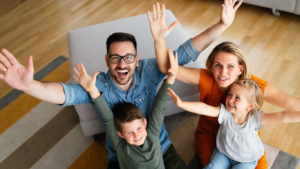After laborious hours of casting which includes fittings, modeling, and networking, all the models finally get to take a lunch break. There is food catered for everyone present, but no one really stops working. No model wants to be the first to take a sandwich, so none of the food is eaten. Instead, a girl pulls out her “kit” of cotton balls. Other models ask if they can have a couple. The cotton balls expand in their stomach in order to keep them full while not making them bloated for the upcoming hours of photoshoots.
The modeling and fashion industry gives unique experiences to every person involved. But one thing seems to always be consistent within modeling agencies, no matter where in the world these models are: Women are never skinny or good enough.
Eating disorders and negative body image are stereotypically known to come to fruition in the high fashion world.
In a study regarding eating disorders among professional fashion models by Antonio Preti, Ambra Usai, Paola Miotto, Donatella Rita Petretto, and Carmelo Masala, it was discovered, “Models reported significantly more symptoms of eating disorders than controls, and a higher prevalence of partial syndromes of eating disorders was found in models than in controls.”
READ ALSO: How FABRIC evolves fashion entrepreneurship in Arizona
Former model, 23-year-old Addie Adams started in the fashion industry when she graduated from high school and was scouted on Instagram. She was told she would do well in modeling abroad. From there, she dove headfirst into the industry. Adams modeled for Beijing Fashion Week and two different agencies, Rising Model Management and Lacoco.
“I had a great mother agency…They were the ones who got me contracts abroad,” Adams said. “Obviously I think I developed some body image issues because of the standards, but I didn’t notice my mental health declining until I started traveling abroad and my job became my person, it became my identity, and it became how I made my money. It became very toxic very fast.”
Autumn Schieferstein, also a former model, slowly made her way into the modeling industry after signing with Donna Baldwin Agency when she was 16 years old. She initially started in beauty pageants and then moved into evening and prom gown modeling. Even with Adams being from Wisconsin and Schieferstein being from Wyoming and both women going into completely different sides of the modeling industry, they had similar experiences regarding body image.
“When you sign with an agency, the expectation is that you remain at the size that you were booked at. And that’s really an unfair expectation to put a 16-year-old under,” Schieferstein said. “I knew since I was 15 or 16 my [body] measurements, and I was fixated with making sure they were staying the same. Even if they would change by a centimeter or so, it was really damaging.”
Adams described that not only did she fixate on her measurements and body weight, but so did her agencies. She explained that she would be weighed every morning and if she gained weight, she would receive less spending money, further perpetuating this standard of being extremely thin.
Adams said that she met people from all around the world like Russia, France, and England. They all felt the issue of maintaining their measurements and if they didn’t, they were dropped and sent back to where they came from.
“You become addicted to booking shows, but also to pleasing others,” Adams said.

Adams’ breaking point was when she was sent home from Beijing for having hip measurements that were too wide. Upon arriving home, she began losing so much weight that her heart went into early stages of heart failure. At this point, Adams knew she needed to go to an eating disorder treatment facility to not only get healthier but to survive.
“Now I am going to start school here in Arizona for psychology so I can be a therapist and help people with disorders,” Adams said. “This time last year, I was getting mentally prepared to die, I wasn’t eating anymore I could feel it. So it’s crazy what one year does.”
This high that both Adams and Schieferstein encountered while modeling is part of what kept them in the business even when times were difficult. Schieferstein also explained that even though it wasn’t explicitly expressed between models, it felt like a shared experience by seeing girls do horrible things to keep up their appearances, such as putting scoops of butter in their coffee to stay full longer.
“It’s seen as unprofessional or like she doesn’t have what it takes if you complain about the industry or anything. It’s kind of like she can’t handle it,” Adams said. “You’re not a person, you’re a mannequin that they want to work with.”
Current male model Heber Maldonado experienced the industry in such a way that has differed greatly from the female perspective of modeling. Maldonado works with Corella & Co. and has been modeling for about one year, starting when he was 21 years old. Maldonado described that he started modeling as a way to improve his self-esteem, but also his sister inspired him to start with a modeling academy.
“It [modeling] really helped me with my self-esteem and in really understanding to love my body even more for who I am. I know I can’t change it so I know I should just accept it for who I am and take advantage of it to the max and let people know that I’m unique,” Maldonado said. “And through that, I want to be an example for others to really love themselves for who they are, and don’t let others decide on what they themselves should be thinking.”
Maldonado explained that Corella & Co. taught him how to pose, model, runway walk, and how to love your body no matter what. Maldonado has done photoshoots and worked with local brands, but has not signed with a modeling agency. Despite having an overall positive experience, Maldonado believes that male models’ main deciding factor is height and that female models have more to worry about when it comes to the modeling industry standards.
“I think there is more pressure for women…For me I’m average height so I’m not like 6 foot, so that in a way indirectly can affect what jobs you get especially in today’s society, how they look for specific attributes in particular male models,” Maldonado said. “And for women in the modeling world, there’s so many more expectations toward women, and it can be a burden or very mentally exhausting for women in this modeling world.”
Looking to change the direction of the profession, Co-Directors of Corella & Co. Gladys Neri and Joecelynn Soto explained their business is driven by diversity and encouraging inclusivity in the modeling industry.
“Our students in most cases struggle with self-confidence, self-esteem, social and communication skills. Our goal is to coach them through these struggles and promote them to live with a balanced mental approach and a positive mental outlook on their appearance. In short, to love themselves the way they are,” Soto said. “We encourage our students to appreciate what they have, not what they don’t have.”
Soto herself has dealt with negative body image issues and was a model in the ’80s and ’90s, which has influenced her drive to change the modeling standards.
“I was a model with an agency and was subjected to a very strict standard of size zero, and conforming to those standards to live out my dream was a learning experience,” Soto said. “Today I share a more positive outlook on how we can change this industry as a whole and provide resources to help future models understand that they can appeal to a broader audience by being themselves.”
Corella & Co. is a modeling development program and includes training once a week for one hour in the span of 24 weeks. There are three levels of training: beginners, advanced and professional. Their mission statement is to, “Define the future of the arts by uplifting our youth and fueling their passions with values, vision, and character.”
“We are aware of the modeling standards in the industry and understand there is a market for this ideal perception ‒ we are working toward breaking those perceptions and standards by creating positive attitudes,” Neri said. “When you sign with an agency, you will adhere to their standards and requirements. They promote your image and book models according to what the brand is requesting in most cases.”
Modeling development programs like Corella & Co. are working hard to give their clients a stronger sense of confidence and purpose while changing the future of the modeling industry standards for the better. However, models like Schieferstein who have been in the business believe there is still a long way to go for standards to become truly realistic and inclusive.
Schieferstein, now 21 years old with wisdom on the industry, thinks that a modeling agency would likely say that they aren’t perpetuating negative eating habits or mental health because they technically provide food and breaks, but Schieferstein experienced these breaks not really being put to use.
“I think they [agencies] do enough to cover their asses. The social pressure that’s created within that is almost greater than whatever food that they have set up for you, that they only have by law, because I am not going to leave to get lunch when not a single other model, stylist, person, leaves. I’m not going to be the first person to walk out of the building.”




